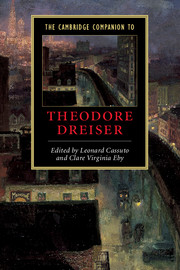Book contents
- Frontmatter
- Introduction
- Part I Backgrounds and contexts
- Part II Dreiser and his culture
- 5 The matter of Dreiser’s modernity
- 6 Dreiser, class, and the home
- 7 Can there be loyalty in The Financier? Dreiser and upward mobility
- 8 Dreiser, art, and the museum
- 9 Dreiser and women
- 10 Sister Carrie, race, and the World’s Columbian Exposition
- 11 Dreiser’s sociological vision
- 12 Dreiser and crime
- Select bibliography
- Index
6 - Dreiser, class, and the home
from Part II - Dreiser and his culture
Published online by Cambridge University Press: 28 May 2006
- Frontmatter
- Introduction
- Part I Backgrounds and contexts
- Part II Dreiser and his culture
- 5 The matter of Dreiser’s modernity
- 6 Dreiser, class, and the home
- 7 Can there be loyalty in The Financier? Dreiser and upward mobility
- 8 Dreiser, art, and the museum
- 9 Dreiser and women
- 10 Sister Carrie, race, and the World’s Columbian Exposition
- 11 Dreiser’s sociological vision
- 12 Dreiser and crime
- Select bibliography
- Index
Summary
Despite a remarkable decline from middle-class respectability to ignominious death in a Bowery flop house, George Hurstwood represents something of a typical figure in the twentieth-century American novel. With the character of Hurstwood, Theodore Dreiser identified white middle-class male experience with profound spiritual alienation and located the source of its problems not in the conventional places of metropolitan modernity - the street, the department store, the hotel - but rather within the putative bastion against the destabilizing forces of modernity: the home. Sister Carrie anticipates an important but neglected tradition of domestic writing by and about men, in which the affluent house owner is understood to possess a material shelter but to lack a proper spiritual refuge; he is, in other words, effectively “homeless.” In contrast with the representations of nineteenth-century domestic alienation explored by feminist literary scholars such as Nina Baym and Lora Romero, in which masculine identity is understood to depend on the rejection of the woman-centered domestic ideal, their twentieth-century counterparts highlight the sense of loss that accompanies the failure of this ideal for the middle class.
- Type
- Chapter
- Information
- The Cambridge Companion to Theodore Dreiser , pp. 100 - 111Publisher: Cambridge University PressPrint publication year: 2004



